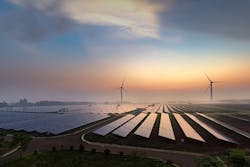Every day, people in positions of authority at the local and national level announce or support ideas to commit to 100% renewables. Some of us cheer when we hear these proposals because we support highly ambitious goals as they can help us accelerate technological innovation. Many of us also cringe because we perceive such a strategy may harbor unforeseen risks or is based on an ideology that may change.
When a jurisdiction announces a policy or binding goal to pursue 100% renewable energy in the future, we need to ask ourselves if we would make the same decision given their situation. Strong influence from constituents, a location-based competitive advantage or financial constraints may be behind the decision. When a company makes such a decision as opposed to a government or regulatory body, a strategic competitive or marketing advantage is frequently involved. Before joining or opposing the movement, governments and regulators should evaluate the potential benefits against: 1) potential lost opportunities such as advancements achievable with the conventional technologies in use; 2) capital and job losses associated with premature retirement of current infrastructure; and 3) potential excess costs over time as movers force-fit technologies into roles for which they are not designed or ready. In addition, as we know from our standard practices for competitive procurement, when we mandate an exclusive direction or otherwise reduce options, there is nearly always a financial penalty.
Moreover, a commitment to limit alternatives in an area as complex as regional or national energy strategy multiplies the risks inherent in long-term planning. Some will claim the United States must eliminate the use of fossil fuels to prevent global warming. While we know a reduction in certain air pollutants would be beneficial, we do not know the long-term environmental implications of a large-scale deployment of land intensive renewables such as wind and solar, including impacts on animals and wildlife, weather alteration and more.
Others caution that state or even federal action to reduce U.S. fossil emissions is of limited consequence when it comes to pollution-caused global warming. They argue that in the power sector alone, nine of the 10 largest power companies in the world, representing roughly 1000 GW, are in countries not constrained by historical climate accords and six are highly reliant on coal. Five of these companies are in China, where electricity demand has grown fivefold since 2000. These utilities rely on coal for 50 to 75% of their power. With interests in the United States discouraging and even restricting the use of coal, U.S. companies and government researchers will be dis-incentivized to contribute to the global development of clean coal and carbon capture technologies.
Let’s say we should commit to decarbonize our power supply here in the United States. Are solar and wind the best options? On a worldwide basis, hydropower is the largest source of renewable electricity, according to the International Energy Agency (IEA). Yet, development in the United States has diminished to a trickle in recent years. At the same time, several U.S. utilities are considering entering into a long-term hydroelectric power contract with Canada. New England was an early leader in hydro power. It seems quite a shame we are not developing more resources domestically instead of considering long-term contracts to import renewable energy.
The United States has an existing carbon-free power source that it is poised to abandon. A growing number of nuclear power plants have retired or are planning retirement for economic reasons before the end of their useful lives. Some entities within our government have argued that the premature retirement of fuel-secure baseload power plants reduces the resiliency of our power systems. Yet our leaders refused to support a U.S. DOE proposal to adopt a grid resiliency pricing rule to protect baseload nuclear plants.
Presumably, the reasoning for this decision was economic. Yet, officials at many levels of our government have endorsed tax credits and emission allowance programs that help tip the economic scales in favor of now well-established renewable technologies and against technologies we expect to need for another 20 to 30 years, including coal and nuclear.
While some of the advantages granted to established renewables seem unjustified at this time, this piece is not a rant against renewables per say. The intended point is, there are many consequences, some unseen, associated with mandating a specific energy direction or limiting choices. Renewables will continue to play an important role in our energy future and should do so competing on a level playing field along with central station fossil fuel technologies, distributed energy sources, combined heat and power, nuclear, demand response, battery resources, transmission and distribution enhancements and more. Instead of betting our future on one strategy, shouldn’t we be striving for an all the above approach to optimize our outcomes under the widest range of future scenarios and at the lowest possible cost to our customers?
About the Author
David Shadle
Grid Optimization Editor
Dave joined the T&D World team as the editor of the Grid Optimization Center of Excellence website in January 2016.
Dave is a power industry veteran with a history of leading environmental and development organizations, championing crucial projects, managing major acquisitions and implementing change. Dave is currently a principal at Power Advance, LLC, an independent consulting firm specializing in power project development, research and analysis, due diligence and valuation support. Dave is also a contributing consultant for Transmission & Distribution World. Prior to Power Advance, Dave held business and power project development positions with The Louis Berger Group, Iberdrola Renewables, FPL Energy and General Public Utilities. He is a graduate of Pennsylvania State University, the New Jersey Institute of Technology and Purdue University.
